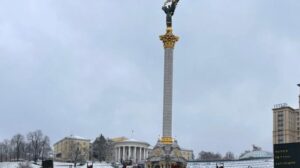
Warsaw Metro will provide Kyiv Metropoliten with 60 subway cars.
This is stipulated in a letter of intent signed between the mayors of Kyiv and Warsaw, Vitali Klitschko and Rafal Trzaskowski, on Wednesday.
The document was signed during a visit to Kyiv by the mayors of four European capitals – members of the Pact of Free Cities – who arrived to reaffirm their support to the Ukrainian capital, the press service of Kyiv mayor said.
The mayors of Warsaw, Prague, Budapest, and Bratislava concluded the Pact of Free Cities in 2019. Kyiv joined the document on September 26, 2022.
Warsaw became a logistic center for transferring humanitarian aid to Kyiv from other European cities and countries, including 2,500 tonnes of food, hygiene items, medicines, as well as pipes and a generator for PJSC Kyivvodokanal, the press service said.

PJSC “Indar” (Kiev), producer of insulin by the end of 2021, has increased its net profit by 6.4 times from 117 thousand UAH in 2020 to 744 thousand UAH.
According to the system of information disclosure of the National Commission on Securities and Stock Market (NKTSBFR), the company’s net profit in 2021 increased almost 1.3 times compared to 2020 – up to 753.184 million UAH.
As reported, “Indar” (Kiev) in 2020 reduced net profit by more than 370 times from 43.017 million UAH in 2019 to 117 thousand UAH. Net income from sales of the company in 2020 decreased 1.6 times compared to 2019 – to 591.543 million UAH.
PJSC “Indar”, created by the decision of the Cabinet of Ministers of Ukraine in 1997 on the basis of Kiev meat processing plant, is a subsidiary of the state company PJSC “Ukrmedprom”, which owns 70.7% of the total number of shares. Another 29.3% of the company belongs to Luraq investments limited (Cyprus).
The manufacturer is included in the list of state-owned objects of strategic importance to the economy and security of the state and is a member of the association “Drug Manufacturers of Ukraine”.

Agroindustrial holding Astarta, the largest sugar producer in Ukraine, has completed its 2022 sugar season, which lasted from September to January, with a total of about 2 million tons of sugar beet processed into 282 thousand tons of sugar.
According to the company’s website on Wednesday, the past sugar season was the most difficult in the holding company’s history, although the volume of sugar produced increased by 6% over the 2021 season, and by 25% over the 2020 season.
It is specified that Astarta’s sugar yield from the raw materials last season was 14.26%, while the Ukrainian average was 13.98%, and 99% of the produced sugar corresponds to the highest quality category.
The holding referred to the preliminary data of Ukrtsukor association, according to which Astarta’s share on the Ukrainian sugar production market in 2022 season was 25%.
The sugar producer specified that its planted areas under sugar beet in central and western regions of Ukraine were not significantly affected by military operations, but it faced a number of other challenges.
“Due to increased costs for fertilizers, crop protection products and fuel, sugar beet cultivation costs per hectare have risen. Nearly continuous rains during the harvest period have made both harvesting the crop and transporting it from the fields to processing plants much more difficult. However, Astarta harvested 1.8 million tons of sugar beets in 2022 at a yield of 56 tons/ha,” the holding quoted its director of agricultural products processing Yevgeny Sadovy as saying.
“Astarta stressed that it was able to implement a number of energy-saving projects at its sugar refineries during the war, in particular, a scheme for autonomous power supply to enterprises in case of a power blackout.
“Astarta is a vertically integrated agro-industrial holding operating in eight regions of Ukraine. It consists of six sugar factories, farms with a land bank of 220 thousand hectares and dairy farms with 22 thousand cattle, oil extraction plant in Globino (Poltava region), seven elevators and biogas complex.
Agricultural holding in 2021 increased net profit 14 times compared with 2020 – up to EUR 122.5 mln, EBITDA – 1.8 times, up to EUR 201.5 mln. Its revenue increased by 18.2% – to EUR 491.35 mln, one third of which (EUR 170 mln) was generated by sugar production and sales.

The mayors of Warsaw, Prague, Budapest and Bratislava are visiting Kiev, the Polish TV channel Polsat News has reported.
Details of the mayors’ visit to the Ukrainian capital are not yet known.
According to media reports, this is the first visit of Warsaw Mayor Rafal Trzaskowski to Kiev after the war started.
On February 15, 2022, Trzaskowski, accompanied by Prague mayor Zdenek Grzyb on behalf of the Pact of Free Cities went to meet with Kiev mayor Vitaliy Klitschko.

State-run Oschadbank (Kiev) has increased the volume of term deposits from the beginning of the full-scale war until the end of 2022 by 7.4% or 5.2 billion UAH – to 70.6 billion UAH in all currencies, the head of the bank Sergei Naumov said on Wednesday.
“As of the end of 2022 we have plus on humble deposits from the beginning of the big war 5.2 billion UAH to 70.6 billion UAH (in all currencies). This trend continues now: already this year we have added UAH 500 million (in equivalent) to this portfolio,” he wrote in his Telegram channel.
He pointed out that the hryvnia deposits from February 24 last year increased by 5.7 billion UAH.
Naumov expects that the deposit base of Ukrainian banks will continue to grow, as well as deposit rates.
Oschadbank was founded in 1991. Its sole owner is the state.
According to statistics from the National Bank of Ukraine (NBU), on November 1, 2022 on the size of total assets Oschadbank took 2nd place (270.806 billion UAH) among the 67 operating banks in the country.

Oil prices are declining on Wednesday morning after reports of a record two-year increase in US inventories of the fuel last week.
The cost of March futures for Brent crude oil on London’s ICE Futures exchange fell by $0.77 (0.96%) to $79.33 a barrel by 7:10 a.m. compared to the value at the close of trading the previous day. Those contracts rose 45 cents (0.6%) to $80.10 per barrel on Tuesday.
The price of WTI futures for February at electronic trades on the New York Mercantile Exchange (NYMEX) is $74.34 a barrel by that time, down $0.78 (1.04%) from the previous session. The contract rose by 49 cents (0.7 percent) to $75.12 a barrel at the end of last session.
Previous day’s report of American Petroleum Institute (API) showed that U.S. inventories climbed by 14.9 million barrels on January 6, following a decline over the past two weeks. The increase was the highest since February 2021.
Traders are now waiting for official data to be released by the Energy Department on Wednesday at 5:30 p.m. Analysts polled by Trading Economics predict that the Energy Department data will point to a 2.24 million-barrel decline in oil reserves. The survey was conducted before the API data was released.
The day before the oil market was supported by expectations of growth in demand for fuel in China as the last restrictions were canceled. At the same time, investors are concerned about the growing number of infections of coronavirus in the country.
“We are confident that oil prices will go back up after the peak of COVID-19 infection in China has passed and economic activity is accelerating,” said Carsten Fritsch, a commodity market analyst at Commerzbank.
The price of March futures on London’s ICE Futures exchange fell by $0.77 (0.96%) to $79.33 per barrel by 7:10 a.m. from the close of trading the day before. Those contracts rose 45 cents (0.6%) to $80.10 per barrel on Tuesday.
The price of WTI futures for February at electronic trades on the New York Mercantile Exchange (NYMEX) is $74.34 per barrel by that time, down $0.78 (1.04%) from the previous session. The contract rose by 49 cents (0.7 percent) to $75.12 a barrel at the end of last session.
Previous day’s report of American Petroleum Institute (API) showed that U.S. inventories climbed by 14.9 mln barrels on January 6 following a decline the previous two weeks. The increase was the highest since February 2021.
Traders are now waiting for official data to be released by the Energy Department on Wednesday at 5:30 p.m. Analysts polled by Trading Economics predict that the Energy Department data will point to a 2.24 million-barrel decline in oil reserves. The survey was conducted before the API data was released.
The day before the oil market was supported by expectations of growth in demand for fuel in China as the last restrictions were canceled. At the same time, investors are concerned about the growing number of infections of coronavirus in the country.
“We are confident that oil prices will go back up after the peak of COVID-19 disease in China and the acceleration of economic activity,” – said a commodity market analyst at Commerzbank Karsten Fritsch.